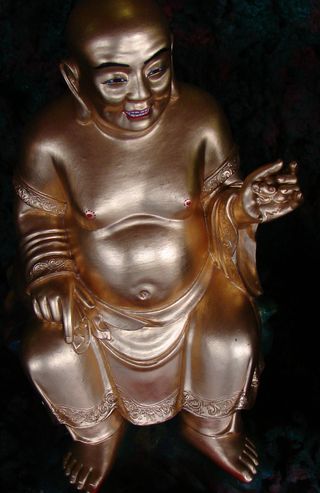
|
Go to
Jordan’s main page,
China Resources main page,
Eighteen Arhats main page, Previous Arhat, Next Arhat. |
Content Created: 2007-03-23 File last modified: Go to Arhat Number 1 2 3 4 5 6 7 8 9 10 11 12 13 14 15 16 17 18 |

In the Five Dynasties period (period 13, AD 907-960), after the break-up of the great Táng 唐 dynasty, in the province of Fújiàn 福建, there lived a monk by the name of Qìcǐ 契此, who was quite astonishingly fat. But people loved him, for he was also quite astonishingly jovial, and quite astonishingly tolerant. In fact he was jovial even to soldiers and tolerant even of children.

This good monk wandered the countryside, begging for his food. Being so fat, he hardly looked like a person starving, but people somehow were always eager to give him food, for he was also always eager to help them in any way he could. Surprisingly, he seemed to be able to persuade rich people to help poor people, and to persuade the wicked to mend their ways.
He carried with him a cloth bag, and people called him the “Cloth Bag Priest” (Bùdài héshàng 布袋和尚), or sometimes even (as today) the “Cloth Bag Arhat” (Bùdài Luóhàn 布袋罗汉), since he seemed so very effective and virtuous, and made people around him feel so comfortable and happy.
Many tales are told about the Cloth Bag Arhat, in which it is recounted that his bag was magical and could take in whole universes or produce wonderful things without count and regardless of size.

Some people say that the Cloth Bag Arhat will someday be reincarnated as the Buddha of the future, Mílè fó 弥勒佛. That is why both of these figures are represented in art as obese laughing men, often with giggling children climbing all over them. When you enter a Buddhist temple, you will usually see a smiling gold statue of Mílè, the future buddha, facing you near the entry, made to look like the Cloth Bag Arhat.
Some people point out that the term “arhat” properly refers to a disciple of the Buddha, and a priest wandering through coastal China in the tenth century can hardly be a real arhat, however much people loved him. So they insist that he should be called the Cloth Bag Priest, although of course, he may still have been a pre-incarnation of the buddha of the future.
The arhat who corresponds to the Indian Ingata, in that case, must be someone else, someone perhaps not fat at all, and perhaps without a cloth bag, perhaps someone who was destined to be reincarnated as the Cloth Bag Priest, and will later be reincarnated as Mílè. Artists who reject the cloth bag/Mílè interpretation simply represent Yīnjiē-tuó as an skinny old man holding a book written in a bizarre and unknown Indian script.
He is said to have had 1,300 lesser arhats under his authority.
For a background note about the Maitreya buddha, click here.